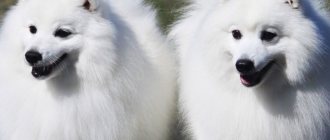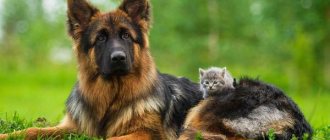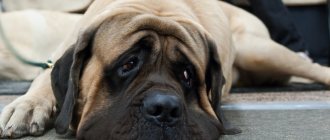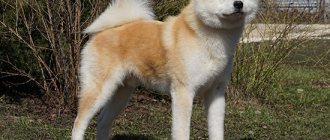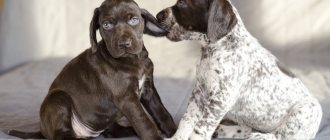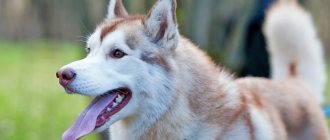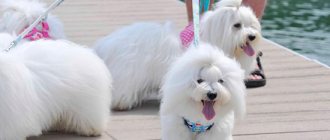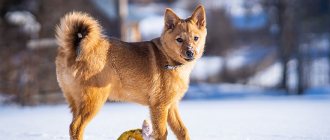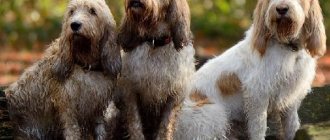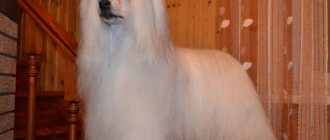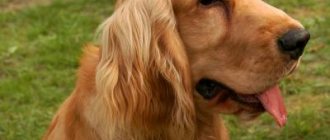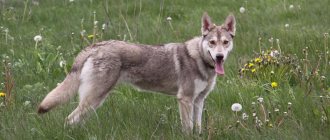The Shalaika is a cross between the northern husky and the southern jackal, a unique breed group bred in Russia. These dogs have an incredibly keen sense of smell. It is the shalaikas who are taking part in the experiment - learning to distinguish between biomaterials of healthy people and those sick with coronavirus by smell.
Of course, the experiments take place without the participation of people. The dog works in the laboratory with samples. Here are 10-11 urine samples from healthy people, and here is one sample infected with COVID-19. The virus itself is no longer in the urine sample, it is safe. But there is a unique set of characteristics that are formed when the human body responds to infection. The task of the husky is to learn to recognize these characteristics and distinguish them from samples of healthy people.
“We use urine samples as the purest material, with the absence of foreign contaminants in the form of cosmetics, perfumes and the like,” says Elena Bataeva, head of the canine monitoring department at Aeroflot airline . - The main task is to have a good component, what to train for - changes in biochemistry, which the dog can identify and compare: all people with such characteristics are carriers of the problem. When this is achieved, the training will be completed."
They plan to receive the first results in early December - then it will become clear what happened and what to do with it next. Will it be possible to teach dogs to work not with samples, but with people? Not yet known. Experiments in this direction are taking place all over the world.
Photo: AiF/Christina Sheks
The history of the appearance of the jackal dog
Klim Sulimov is a scientist and dog handler who developed the Shalaika breed
Shalaika is a new breed of dog. It was officially registered and recognized by the RKF in 2021, but its history began much earlier.
We owe the appearance of the shalayka to a Russian biologist engaged in research in the field of cynology, Klim Sulimov. He created a hybrid of a jackal and a dog. Work began in 1973. Initially, the goal of this selection was to obtain a super dog that would help fight drug trafficking and illegal trade in rare wild animals. It was necessary to create a bloodhound with a unique sense of smell, capable of working in any conditions.
For these purposes, Sulimov chose the Central Asian common jackal and the Nenets reindeer herding dog (Laika). This was explained by the following factors:
- The jackal is 60% herbivore and has an excellent sense of smell for various plants, including those from which drugs are produced. In addition, it can live in hot conditions and can easily tolerate temperatures of 40 degrees. The jackal is small in size, which was also important for selection. The animal had to quietly crawl under the seats on the plane, without attracting people's attention while working.
- The reindeer husky also has a good sense of smell, has high intelligence, and can live and work in conditions down to minus 60–70 degrees.
But it was not possible to achieve the crossing of adult jackals and huskies - wild animals did not accept dogs. It was necessary to adapt them.
To do this, it was decided to take four-day-old jackal puppies for breeding and feed them to the husky. The kids grew up and recognized the dogs as their own. Selection work was carried out for 7 years. As a result, they managed to get the first offspring, which were half dogs, half jackals. But the individuals turned out to be unsuitable for training and work - they had too many genes of a wild animal that is terribly afraid of people.
The hybrids were once again crossed with a husky and obtained offspring that were only 25% jackal. These were the first puppies of Sulimov's dog, which were quickly dubbed Shalaykas.
These dogs are also called “quaterons” - from “quart”, that is, “quarter”. Other names for the breed are Shakalaika, Shabaka. The official name is jackal-dog.
The new dogs took the best from both the jackal and the husky. They are small, nimble, very smart, easily tolerate any natural conditions, and thanks to their small size they can crawl into any crevice. Their only drawback was that the dogs did not become attached to people - they could work well, but they did not perceive humans as owners. But it turned out that this is even better for the service - jackalaikas can calmly interact with various canine specialists.
Shalaika perfectly follows the commands of any dog handler working at the airport.
Sulimov's dogs are bred in the kennel of the Aeroflot security service at Sheremetyevo Airport; now about 50 dogs live and work there. All conditions for living and training have been created for the animals. There are special rooms where situations for searching for harmful substances are simulated, and even an airplane in which the skill of searching for dangerous and unauthorized items is honed.
In the 80s and early 90s, dogs were successfully used to search for narcotic substances, with success rates reaching 95%. Shakalaikas also helped to find illegally transported animals or their parts (derivatives).
Sulimov's dogs have a unique sense of smell; they can even distinguish between traces of men and women by smell, which was of great assistance to law enforcement agencies.
In 2002, Russia faced the problem of terrorist attacks. It turned out that jackalaikas can help here too - detecting explosives even in minimal concentrations. Animals were specially trained to find hexogen, and they began to work in this direction.
Sulimov's dogs identify hexogen with great accuracy: for example, false recognition accounts for 1 case out of 200.
Video: Sulimova's super dog
Content Features
In the Aeroflot nursery, shawls are kept in small enclosures, but this does not mean that they sit in them for days on end. The working day of a detective dog lasts on average 12 hours. The enclosure is a small three-story building. Wool and excrement fall through the mesh floor into a tray where natural fermentation of the waste occurs. Thanks to this, the dogs are always clean. One of the features of hybrids is the ability to live and work at extreme temperatures - from –50 to +40 °C.
Care
Shalaikas are absolutely undemanding in terms of care. Seasonal shedding is quite abundant, the rest of the time it is moderate. Short hair requires infrequent brushing and even less frequent bathing. Dirty has a specific dog smell. Clean the ears as necessary and monitor the length of the claws. Normally, they wear off on their own.
Description of the breed according to the RKF standard
The main job of the shalaika is to detect explosive or dangerous substances
The breed standard was approved by the Decision of the Presidium of SOKO RKF on June 15, 2018. Shalaika according to the FCI classification belongs to the fifth group - “Spitz and primitive dogs”.
The purpose of breeding is detection (recognition) of odors. The dog is intended for official use and airport security work.
Shabaka in appearance resembles a medium-sized husky and is below average in height. The animal is of regular build, agile, harmonious, almost square in format. The ratio of body length to height at the withers is 10:9. The difference between males and females is not particularly pronounced outwardly.
Size and weight:
- height 38–42 cm (deviation within 3 cm is allowed);
- weight not less than 7 kg and not more than 15 kg.
The peculiarity of the dog's appearance: in its muzzle and head structure it is similar to its wild relatives - jackals. This is expressed in the look, the shape of the eyes, facial expressions, and mobile, medium-sized erect ears.
The shawl has a non-massive muzzle with very well developed whiskers (vibrissae). The limbs can be described as dry, strong, but at the same time graceful. The short tail is normally carried over the back. The eyes are very expressive, the color varies from light to dark brown.
Sulimov's dogs are very active. Their movements are free and easy, well coordinated and fast. Running is characterized by trotting and ambling, easily turning into a gallop.
The medium-length coat is characterized by the so-called wild type of hair, the guard hair is coarse, the undercoat is soft. Outwardly, this makes the dog bulkier.
Jackalayas have a special structure of paws (front and rear). The middle pads can be fused, resembling a heart in shape. This structural feature, inherited from the jackal, is regarded as a morphological characteristic desirable for the breed.
White markings are allowed in any color variant of the shawl.
There are many color options for dogs of this breed. The most common:
- zonal gray;
- zone-red;
- red of varying intensity;
- sable;
- with or without a dark mask.
All colors can have white markings, perhaps a small speck.
First generation
The process of breeding the Quateron breed took approximately seven years, since jackals do not live with dogs, it was necessary to place jackal puppies in a female husky so that in the future the jackals would get along with dogs. During the breeding process, male jackal puppies were fed by female Nenets reindeer huskies. This was done so that in the minds of the “mestizos” an image of the behavior of a dog, and not a jackal, would be formed. However, the first generation of hybrids could not be trained and were quite wayward. Then it was decided to cross the “mixed breed” with the Nenets reindeer husky. The result was worth it: a breed was bred that is only ¼ jackal (hence the quadroon, quart - four)
Disadvantages and disqualifying vices
Airport workers focus not on external data, but on the service qualities of the dog
Any deviation from the characteristics described in the Jackal Dog breed standard should be considered a fault:
- roughness or looseness of build, short legs;
- pronounced tilt of the body;
- raw lips or eyelids;
- narrow shallow chest;
- motionless hanging tail;
- straightened angles of the front or hind limbs;
- saber tail;
- lack of undercoat;
- straight, soft, silky coat.
Disqualifying faults:
- aggressiveness and excessive cowardice;
- obvious physical or behavioral abnormalities;
- long hair, tight curl or cords on any part of the body;
- bobtail, docked tail;
- semi-erect or hanging ears;
- flesh-colored nose;
- undershot, overshot, jaw misalignment;
- absence of fangs;
- fangs growing into the gums or palate;
- blue eyes, odd eyes;
- clumsiness, constrained movements;
- blue, brindle, marbled color;
- smooth coat.
Particular attention is paid to male dogs, which should have two normally developed testes, completely descended into the scrotum.
Further work on the breed
Shalaiki is another name for Sulimov’s dogs
- The first generation hybrids of crossing a jackal with a domestic dog had one insurmountable character quality: some of the puppies were very wild. Moreover, the natural wildness of the jackal was enhanced by the high excitability of the nervous system characteristic of dogs. It was impossible to tame such puppies, much less force them to work.
- Subsequently, in the third and fourth generations of hybrids, fear of humans manifested itself only in some puppies. An interesting pattern: with each generation, puppies began to fear humans at a later age. In quarter dogs, fear began at eight months, but dog experts have found a sign that can be used to determine whether a puppy will run wild or not. A one and a half month old baby, who will show signs of savagery, is indifferent to the person, avoiding the dog handler.
When conducting breeding work, scientists took into account all aspects that could in the future affect the working and usable qualities of the new breed. For example, jackals and the first generations of hybrids chewed their food especially carefully, which means that any medicinal additives cannot be fed with food. This makes it difficult to treat animals.
Other behavioral responses that differed between dogs and jackals, such as intimidating postures, howling or barking, and tail holding, allowed dog handlers to determine the predominance of dog or jackal genes in a particular animal.
How quickly Cane Corso puppies grow: features of socialization and education.
Independent and cheerful: all about the husky dog breed.
What to do if your dog has diarrhea? How dangerous is this condition?
Behavioral characteristics of Sulimov's dog
Jackalayas have no sense of attachment to humans
The breed got its character from jackals. Dogs are so independent that they do not show any affection to humans and work only in exchange for treats. Close communication with a person is avoided.
Despite this, Sulimov's dogs are very friendly and easy to train. They have a high level of intelligence and a cheerful and lively temperament. From an early age, puppies demonstrate extraordinary intelligence in performing complex tasks.
Animals can communicate very well with each other, demonstrating amazing abilities that are completely unusual for dogs. This breed is not intended to be a companion and will never be on friendly terms with its owner.
A case is described when a six-month-old puppy got a bone stuck in his throat and he did not give in to either his instructor or other people, but only accepted help from an adult shalaik, freezing and allowing him to get the bone.
Origin story
Shalaika has many names - Sulimova's dog, quarterron, shakalaika. She was bred, as you might guess, by Klim Timofeevich Sulimov for the sole purpose of creating an ideal bloodhound. This goal has been fully achieved by the author of the breed. The dogs turned out to be very energetic, with an amazing sense of smell, while being unpretentious, hardy and hard-working.
Sulimov came up with the idea of breeding such a breed because he is familiar first-hand with the shortcomings of service breeds of dogs, first of all, their sense of smell, which is not capable of detecting the finest odors.
The task set before him was precisely to breed a breed that would have a heightened sense of smell, while at the same time being highly trainable. After much thought, Sulimov “laid” the Nenets husky reindeer husky and the jackal as the basis for the future breed. There are reasons for this. Jackals are omnivores, unusually smart, nimble, and small in size. As for the Nenets reindeer huskies, these are dogs belonging to the Spitz breed group, but formed in harsh tundra conditions. These are not sled dogs, but assistants in herding deer. With their barking, reindeer herders do not allow individual animals to disperse far from the herd, driving them together. They are temperamental, agile, attentive, and very attached to their owner. At the same time, they have such properties as independence and love of freedom, since they are accustomed to making decisions without the owner’s commands.
Breeding of the breed began with jackal chicks raised by dogs. Suitable puppies were found at the Baku Zoo; they were raised by a Nenets reindeer herder under the supervision of Sulimov. Mating of grown puppies was carried out with the same dog. The first cubs - half jackals, half dogs - were received only in 1977. Their sense of smell was super-strong, but it was impossible to train them; their fear of humans was insurmountable. After 5 years, dogs were obtained that had ¼ jackal blood, and they completed the task assigned to Sulimov. This is how the name quadron appeared. These puppies stopped being very afraid of people, began to chew the food offered to them more thoroughly, and not swallow it immediately, which is typical for jackals; accordingly, the process of their digestion was established, as was primary socialization.
Thanks to the sense of smell and omnivorous jackal genes, quadroons are able to recognize even the slightest traces of plant drugs, as well as synthetic drugs. This makes representatives of the breed universal bloodhounds, aimed specifically at searching for prohibited substances. Currently, more than four dozen shalaikas are working in the field of aviation security at various airports across the country.
Choosing a puppy and price
Shalaika puppies need early socialization, otherwise the dog will be overly cowardly.
It is not possible to buy a jackal dog puppy for private ownership. These animals are bred exclusively for work.
Theoretically, choosing a puppy is quite difficult - the breed does not have strict color requirements; individuals are very diverse in appearance. One litter can have puppies with different coat types. To an inexperienced dog breeder it may seem like these are just mongrels.
Since the dog is for official use, the experts have their own criteria: it must have good search data and dominant properties, and this is inherited. Therefore, to choose a good puppy, you need to look at the pedigree: more jackal genes mean that the dog has a better sense of smell.
The Aeroflot nursery employees themselves say that these puppies are priceless.
Sulimov's dog can only fall into private hands in old age or if due to some disqualifying defects it cannot be hired.
Breed creation process
As mentioned above, the first results of selection appeared only after 7 years of work. However, dog handlers and scientists did not immediately come to the classic version. Initially, experts were engaged in crossing huskies with wolves and jackals. Since wolves have a less acute sense of smell compared to jackals, it was decided to continue further work with the latter. In addition, the jackal is considered an omnivore, feeding on both berries and vegetation, therefore, it is able to identify the plant raw materials of drugs.
Care
The general principles of caring for a shawl do not differ from the requirements for keeping any breed of dog.
Shabaka does not require special care. This unique breed can live in any conditions: both cold and hot. Like huskies, these animals sometimes shed; during this period, it is advisable to comb out the hair that falls out.
Representatives of the breed treat water well, but they need to be bathed only when necessary. They eat little; these animals do not need to trim their claws.
At the Sheremetyevo kennel, dogs are kept in special enclosures. To maintain their performance, they require a balanced diet: meat, cereals, vegetables, vitamins, as well as active walks and fresh air.
Origin story
The West Siberian Laika was bred by hunters and dog handlers based on several local offspring: Khanty, Ostyak, Mansi and Vogul Laikas, mainly distributed in the region of Northwestern Siberia and the Northern Urals. These dogs have long been famous for their large size, attractive appearance and working qualities. However, a more significant role in the development and formation of the breed was played by centuries-old strict selection of dogs for working qualities in the conditions of the harsh taiga. The fishermen did not keep parasites and tried to keep their best breeders with themselves, guarding the nests, and sometimes even hiding them.
One of the founders of the breed was a male named Grozny, who belonged to the Sverdlovsk Service Dog Breeding Club. He was born in 1930 and left behind many good descendants. The Sverdlovsk group remains one of the strongest to this day, although recently it has been slightly inferior to the Moscow one.
Of all the factory huskies, West Siberian huskies already at the end of the 50s represented a well-defined breed group. Moreover, breeders did not resort to inbreeding, but sought to consolidate the desired qualities by selecting similar sires of different bloodlines, which had a positive effect on the health of the livestock and its genetic potential
Training
One of the types of training is special bookmarks, among which the shalaika must detect a dangerous or prohibited substance
Sulimov's dogs are very trainable. Training begins at 10 months. This age is considered optimal for starting training to search for explosives and narcotic substances. For training, specially equipped rooms and bookmarks at the airport are used. Dogs need exercise every day - only then will they be able to work efficiently.
Shalaika's special abilities
- She can smell a sick person, who can only be distinguished from a healthy person by the results of a medical examination.
- They have surprisingly strong ligaments, and the entire musculoskeletal system. They talk about a case when a dog landed unharmed on its paws and ran away, jumping out of a fifth-floor window.
- They are the only known breed that can distinguish the sex of a person by smell. This is especially valuable for criminologists, as it allows you to significantly reduce the number of suspects and speed up efforts to find them. An ordinary dog, especially, cannot do this.
- They are capable of smelling explosives in minute doses with their incredibly subtle sense of smell. They tell how a dog smelled the smell of gunpowder in a suitcase hidden deep, on the packed suit of a man who had hunted in it some time ago.
- Even modern devices cannot compare with the ultra-precise sense of Sulimov’s dog. Only one time in two hundred can an alarm be false.
- A traditional breed service dog needs rest after half an hour of work. Sulimov's dogs are able to work up to 15 hours continuously (although they are replaced every half hour). And they don’t care at all that they are not recognized as a breed. They just work as if they were playing. And no other airport in the world has anything like this in its arsenal.
